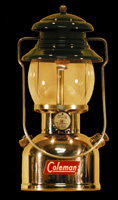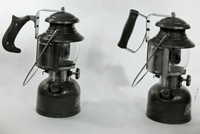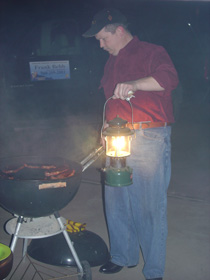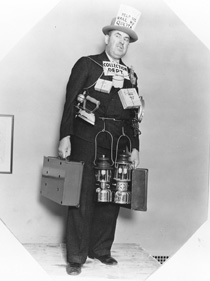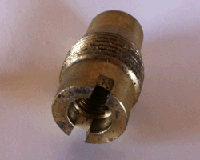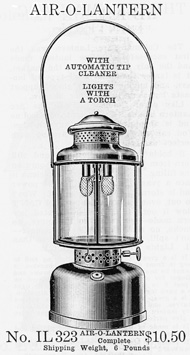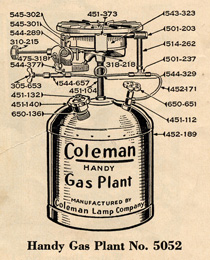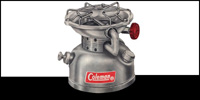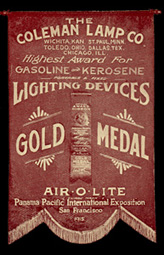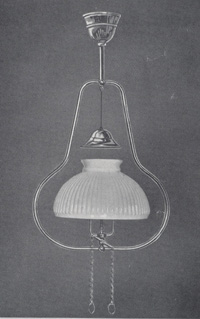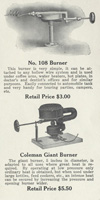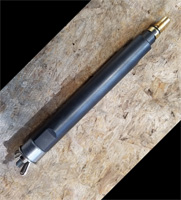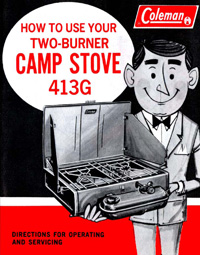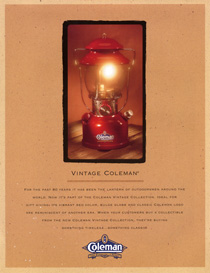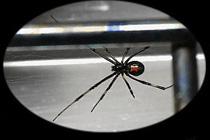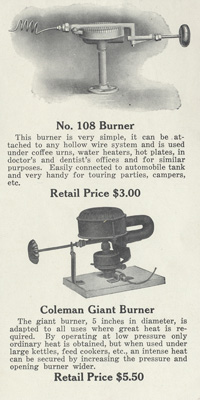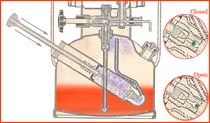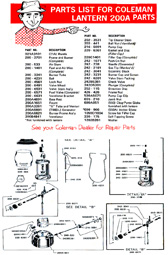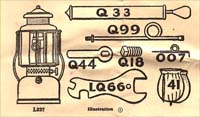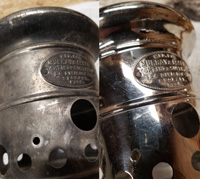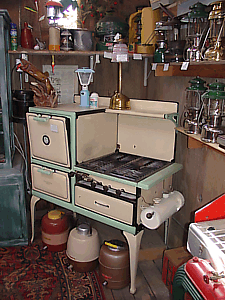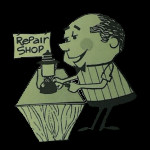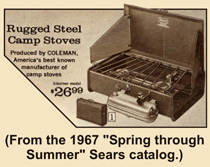 Rebuilding Coleman® Two or Three Burner Stoves
Rebuilding Coleman® Two or Three Burner Stoves
Chapter One: Disassembly
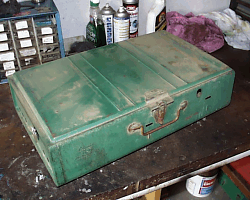 |
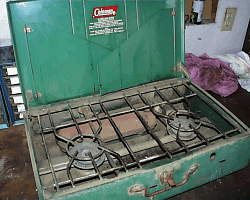 |
1.1 Drain the old fuel. Pour the old fuel into an approved container for disposal. Use a length of small clear tubing to siphon what you can’t pour out. You can find a local hazardous waste recycling facility by doing an internet search. Set the tank aside.
1.2 Remove the grill(s). Some grills sit loosely on the stove while others have clips to hold them in place. If yours are loose, simply remove them.
Some stoves have clips that are secured to the case with a nut and bolt. If your stove uses this method, use a medium flathead screwdriver and a 7/16” wrench to remove the grills.
If they are attached to the stove case with clips only, which is most likely what you will find, I recommend that you leave them alone. They are locked into place with barbs and are very difficult to remove. You can work around this problem by flexing the grill’s arms to free them from the clips.
Turn the case so that one end of it is facing you and lift the grill into a vertical position. Grasp the grill close to where the clip is and pull it outward (Figure 1). You will see it flex (maybe even bend slightly) and then come free of the clip. When it does, push the grill to the other side of the stove to free it from the opposite clip. Repeat if you have two grills. Set the grill(s) aside.
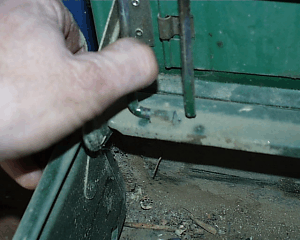 |
Figure 1 |
1.3 Disassemble the burners. In the center of each burner is a large pan screw, called the burner screw. Use a medium flat tip screwdriver to remove each burner screw as shown in Figure 2. If they will not turn, spray them with penetrating fluid and allow to sit for a few minutes. You can also tap on the scrrewdriver handle a few times with a small hammer.
![]() Note: Your stove has a master burner and one or two auxiliary burners. The master burner is always the nearest to the generator and the auxiliary burners will have an external valve to control them. They may be of different sizes.
Note: Your stove has a master burner and one or two auxiliary burners. The master burner is always the nearest to the generator and the auxiliary burners will have an external valve to control them. They may be of different sizes.
As you pull off the burners, look at them closely for later reference. Each burner consists of a burner cap, a set of burner rings, a burner bowl and the burner screw (Figure 3). The master burner may also have a baffle plate that sits under the filler rings (Figure 4). As you disassemble the burners, notice that you have flat and corrugated burner rings. There should be four flat and three corrugated with a flat ring on the top and bottom. Set the burners aside.
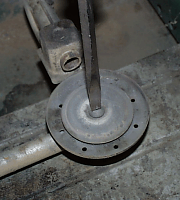 |
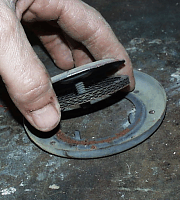 |
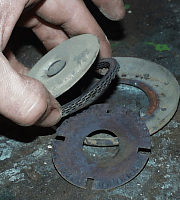 |
Figure 2 |
Figure 3 |
Figure 4 |
1.4 Remove the manifold. The pipes you see inside your stove are collectively referred to as the manifold. At the back of the stove, locate the area where the “U” in the Manifold is secured to the case with a nut and screw (Figure 5). Use a flat tip screwdriver to turn the screw while you hold the nut with your fingers. Remove the nut & bolt and set them aside.
Turn the case on end and look at the underside (Figure 6). You will see two (or three) large holes in the bottom. If you look into those holes you will see pal nuts that hold the manifold to the case (Figure 7). Use a 7/16" nut driver or socket with extension to reach and remove them.
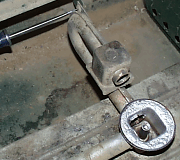 |
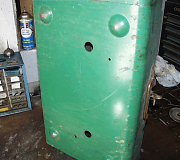 |
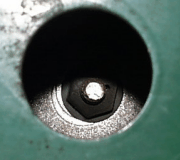 |
Figure 5 |
Figure 6 |
Figure 7 |
With the pal nuts removed, work the manifold back and forth to get it out. The control shaft for the auxiliary burner(s) is pretty long so take your time and be patient. Once you have the manifold out, set it aside.
1.5 Remove the drip tray. Set the case down flat and turn it so you can see one of the ends. You will find two or three screws there, and they secure the drip tray (Figure 8). Remove the screws on one side, then the other. With the screws out, remove the drip tray and set it aside.
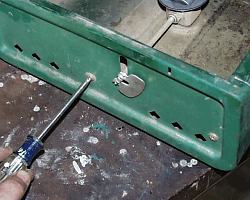 |
Figure 8 |
1.6 Remove the legs. If your stove has legs folded up inside the case, they are easily removed. Push in on the ends until they disengage, the pull them out.
![]() Note: It is easy to remove the lid on some stoves, but you don't need to. You can wash the lid along with the case.
Note: It is easy to remove the lid on some stoves, but you don't need to. You can wash the lid along with the case.
You case has been disassembled now so set it aside and get the tank on your workbench.
1.7 Test the check valve. If you can, now is a good time to test the function of your check valve. This is possible if the pump is working and the fuel filler cap holds pressure.
Turn the pump fully counterclockwise and give the tank 20-25 pumps. Press the pump all the way down and let go of it. Rest a finger lightly over the hole in the pump handle and see what happens. If your tank is pressurized and nothing happens, your check valve is working properly. If the pump raises your finger upward the check valve is leaking.
If it lifts your finger very slowly, you can probably get away with not removing the check valve, because the air stem is a positive stop safety for you. However, if it pushes your finger up quickly, you need to clean or remove the check valve.
1.8 Disassemble the valve. Turn the valve wheel fully counterclockwise. Spray the valve stem with carburetor cleaner and use a small wire brush to clean the grease and dirt from the valve stem. Return the valve wheel to the fully clockwise (closed) position.
The first part to be removed will be the generator tube. There is usually a wrench fitting on this tube, near the point where it attaches to the valve. If you have a fitting, use the appropriate end wrench and turn the tube counter-clockwise. If there is no fitting for a wrench, use a pair of pliers or vice grips to turn it (Figure 9).
Once you have the generator tube free from the valve, slide the tube and the generator coil inside off the cleaner rod (Figure 10).
![]() Caution! The tip of the cleaner rod is extremely sharp!
Caution! The tip of the cleaner rod is extremely sharp!
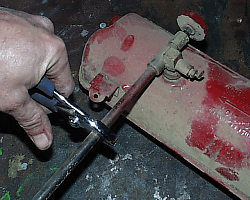 |
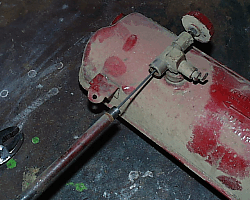 |
Figure 9 |
Figure 10 |
While holding the valve wheel closed, use a 1/2” end wrench to turn the valve stem nut counter-clockwise (Figure 11). Do not allow the valve stem to turn while you do this. Continue turning the nut until the threads release from the valve body.
When the valve stem comes free as shown in Figure 12, pull it completely out of the valve . Use caution as the tip cleaner rod is be attached to it. Do not to bend the tip cleaner rod and be careful as the tip is very sharp.
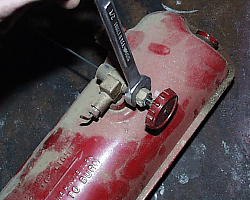 |
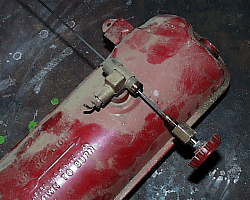 |
Figure 11 |
Figure 12 |
Use a pair of pliers and grab the tip cleaner rod near the valve stem (Figure 13). Grip it firmly, then turn the valve wheel counter-clockwise to separate the valve stem from the needle. Set these pieces aside.
Take a small flat tip screwdriver and remove the screw in the center of the valve wheel. Pull the valve wheel off the valve stem, then the valve stem nut. As you remove the nut, watch for the small brass valve stem packing retainer. It will probably be loose and obvious, but it may stick to the valve stem nut where it can later fall off. Set generator and valve stem aside (Figure 14).
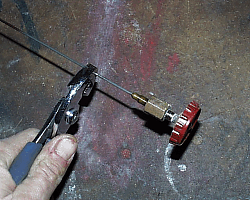 |
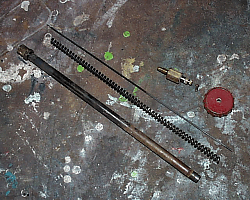 |
Figure 13 |
Figure 14 |
1.9 Remove the valve. Turn the tank upsidedown and place the squared top of the valve inside the jaws of your bench vise (Figure 15). Keep the tank level as you snug the vise down on the valve.
What you want to do is unscrew the tank from the valve. Grab the tank firmly with both hands and slowly turn it counter clockwise, ensuring that you stay level as you turn. Once it comes free, release the vice and then unscrew the valve from the tank by hand (Figure 16). Set the tank aside.
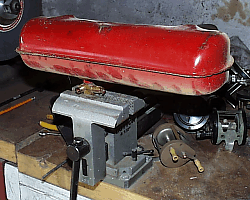 |
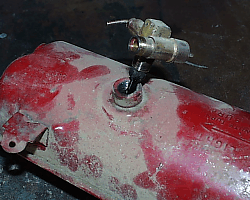 |
Figure 15 |
Figure 16 |
1.10 Loosen the fuel tube. Hold the valve in your hand and use a wrench or pair of pliers to turn the fuel tube counterclockwise. Once it comes free, loosely thread it back on and set the valve aside. We will not be removing the valve’s block & needle assembly so we can keep the fuel tube attached to protect the needle.
![]() If you are not going to replace the valve stem packing, skip this step.
If you are not going to replace the valve stem packing, skip this step.
1.11 Remove the old valve stem packing.
![]() Caution: This step will destroy the valve stem packing in your stove. If you don’t need to replace it, I recommend that you skip this step. If you are working on a 425 model stove, ensure you have the correct packing size as it is different than the larger stoves.
Caution: This step will destroy the valve stem packing in your stove. If you don’t need to replace it, I recommend that you skip this step. If you are working on a 425 model stove, ensure you have the correct packing size as it is different than the larger stoves.
To remove the valve stem packing we need to break it into little pieces. Look closely at the inside of your valve stem nut. You will see that the packing is pressed tightly against the threads (Figure 17). Set the nut down on your work bench with the large opening facing up. With a medium flat-tip screwdriver, angle the blade down inside to where the threads meet the old packing (Figure 18).
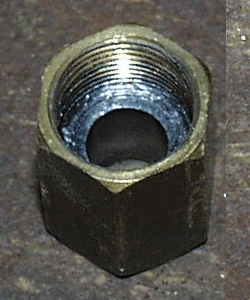 |
 |
Figure 17 |
Figure 18 |
Press down hard on the screwdriver to “cut” into the packing. Slice it through to the threads, all the way to the bottom. With one cut into the packing, spin it around and do it from the opposite side. Continue until it breaks apart and you can completely remove it (Figure 19).
The old packing must all be completely removed from the bottom end of the nut. Use a wire brush and carburetor cleaner to remove it. Set the valve stem nut aside.
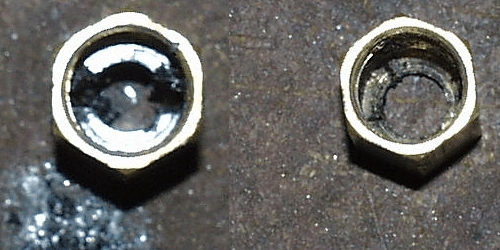 |
Figure 19 |
1.12 Remove the pump. Turn the tank so that you can see the pump and locate the pump cap, which is held on by a small pump clip. Use a small flat tip screwdriver and pry away one side of the clip, then the other (Figure 20). Set the pump clip aside.
 |
Figure 20 |
Take some household cleaner and wet the pump cap down. Allow a few minutes to soak. Use a firm soft brush to remove the grease and oil from around the cap.
Grasp the pump handle and pull it up until you feel it reach the top. Give it a good upward tug to unseat it from the tank.
If you are unable to unseat the cap after pulling up firmly on the pump, you might need to pry it off. Place the blade of a small flat-tip screwdriver under the bottom edge of the cap and gently lift, working your way around until it comes free. Be careful not to damage the finish on the tank. Set the tank aside.
1.13 Disassemble the pump. Turn your pump upside down to see how the pump cup is being held on. You may see some variation of a hex nut, or a thin self-locking “push-on” nut (Figure 21). Also note the flat surfaces on the round pump shaft, near the bottom end. Use these flat areas to hold the pump with pliers or wrench.
If your pump is the style with a nut, use an adjustable wrench to turn it counterclockwise and remove. If it is the style with a push-on nut, place a small flat-tip screwdriver blade between the nut and the pump cup and carefully pry it off the end of the shaft. With the nut removed, remove the pump cup. Grab the outer edge of the backing plate with pliers and turn it counterclockwise to remove. You can now slide the return spring and pump cap off the pump. The disassembled pump is shown as Figure 22.
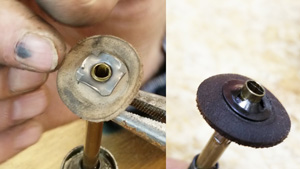 |
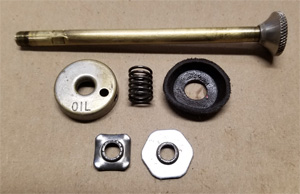 |
Figure 21 |
Figure 22 |
Inspect the condition of the leather pump cup. If it just dried out but appears to be intact, you can probably revive it. If the leather has rotted, or has torn somewhere, it needs to be replaced.
1.14 Remove the fuel filler cap. Unscrew the fuel filler cap from the tank. I ALWAYS recommend using a new replacement cap whenever possible.
If you have an original cap that color-matches your stove, polish it with the tank and use it for display. When you use the stove, install a replacement cap.
If you have a 242-series lantern, there is not a replacement filler cap available for your lantern and you will need to replace the insert gasket.
1.14 Disassemble the (3-Piece) fuel filler cap. This is the common filler cap with a panhead screw in the center. Reinstall the cap on your tank and tighten it down as much as you can with your fingers.
Note that there is a gap between the top of the cap and the bottom of the screw. Spray this junction with penetrating fluid and wipe away the excess. Allow it to sit for a few minutes.
Locate the flat tip screwdriver that best fits the center screw in your filler cap. Place the blade in the slot, aligning the screwdriver squarely down on the center screw. Apply firm downward pressure and attempt to turn the screw counterclockwise. If it comes free, remove it and set it aside.
If it seems to slip as you turn the screw, the fuel filler cap is not tight enough. Re-tighten the cap with your fingers and try turning the screw again. You can also tap lightly on the handle of your screwdriver with a wrench or small hammer a few times.
If the screw will not come out after hand-tightening three or four times, you will need to use pliers. Wrap a rag around the filler cap and gently approach it with slip-joint pliers. Be very careful and don’t scratch the tank as the jaws turn. Be gentle on the squeeze but don’t allow them to slip either.
Once you finally have the screw out, loosen the filler cap and remove it. You should find the insert still sitting on your tank. Pull it off and set it aside.
1.16 Remove the air stem. With the pump removed from the tank you can see the air stem down inside the pump cylinder. Use needle-nose pliers to turn it counter-clockwise until loose (Figure 23). Use your fingers to continue turning, then remove. Set the air stem aside.
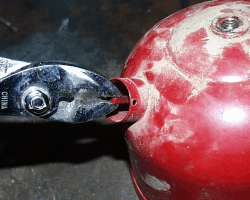 |
Figure 23 |
1.17 Test and/or remove the check valve. As I stated previously, you do not want to remove the check valve unless you need to. If you were able to test it earlier and know that it is good, you are done.
If you were unable to test it, you can do a simple test now. Clean the outside of the pump cylinder well, the place your mouth around it (yuk!). Blow into the tank, then try to pull air out of it. If you can't pull air out, the check valve is probably working just fine. You will be testing it again during re-assembly so if you have a problem you can deal with it then.
The location of the check valve is shown in Figure 24. If you need to remove it please visit the page on how to do this.
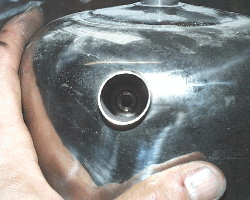 |
Figure 24 |
Congratulations! You’ve finished tearing apart your stove!
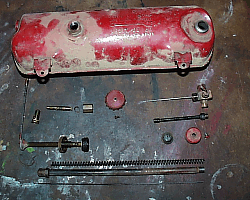 |


